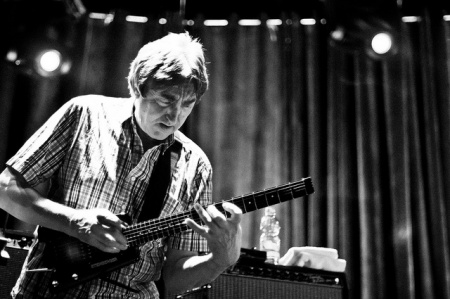Allan Holdsworth

This is an unsourced biography written by The Allan Holdsworth Archives. All factual information is supported by information contained on this website, allanholdsworth.info. Some viewpoints are subjective, but we believe them to be well supported by the musical community.
Allan Holdsworth (1946-2017) was a British musician, composer and bandleader. He was primarily known for his work on electric guitar, and to a somewhat lesser extent for his use of the SynthAxe synthesizer controller. In addition, he also occasionally performed on vocals and violin, live and on record, especially in earlier years. Later in his career, he would record, produce, engineer and mix his own records from his home studio, "The Brewery".
Holdsworth's musical style was often referred to as jazz-rock or fusion, although he disapproved of such labels. His music was influenced by jazz in that he devoted most of his energy to improvising on chord changes, but rhythmically and sonically he drew heavily on rock, and harmonically he created a very personal amalgam of jazz harmony blended with contemporary classical music of the 20th century. He eschewed traditional forms such as the blues or jazz standards, with a few notable exceptions.
Holdsworth was known for his distinctive guitar work both as a soloist and accompanist. His guitar solo work pioneered the use of legato technique combined with sophisticated signal processing, harnessing amp distortion, to create a fluid sound recognized by fast and harmonically complex scalar runs, which has drawn analogies to John Coltrane. His chordal work is recognized by a pianistic approach, with the use of close intervals and unusual chord voicings, and a sophisticated use of delay, chorus and pitch shifting, to create a lush, ethereal sound.
A prime example of his skills as a guitar soloist can be found on the track "Devil Take The Hindmost" from the album "Metal Fatigue" (1985). Likewise, a prime example of his chordal playing can be found on the track "Above And Below" from the album "The Sixteen Men Of Tain" (2000). The SynthAxe was introduced on "Non-brewed Condiment", the first track off his 1986 album "Atavachron".
Biography
Allan came from Bradford in Yorkshire and played in local bands there (see Early Days). His father, Sam Holdsworth, was a jazz pianist, and Allan's first music teacher and mentor. In the early 70s, he moved to London and played with a wide assortment of groups, notably Tempest and Soft Machine. In the mid 70s, he also stayed a period in the U.S.A., recording and touring with Tony Williams. On returning to England, he recorded with Gong, Bruford and U.K., among others. He released his official debut album, "I.O.U.", independently in 1982. Frustrated by a lack of opportunities in England, he migrated permanently to California in the early 80s. There, he started a long-running solo career, releasing several solo albums and doing several world-wide tours, in addition to doing scattered work as a session musician and guest performer. From the mid 80s, he became a pioneer in the use of the SynthAxe synthesizer controller. His last studio album featuring a band was "The Sixteen Men Of Tain" (2000), followed by the mostly one-man SynthAxe solo album "Flat Tire". In later years, his recording output and touring diminished, partly due to health reasons. In April 2017, shortly after the release of the box set "The Man Who Changed Guitar Forever", Allan passed away at his home. Since his passing, Manifesto Records has released several live albums that contain a combined CD and DVD, culled from TV broadcasts and jazz festival footage.